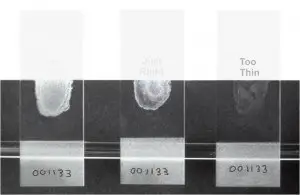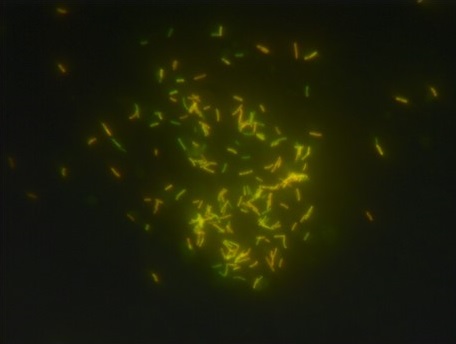Table of Contents
What is Auramine- Rhodamine Staining?
- The Auramine-rhodamine fluorochrome staining technique, often known as the “Truant method of staining,” is utilised to visualise acid-fast bacilli (AFB).
- In undeveloped nations, the Ziehl-Neelsen (hot) and Kinyoun (cold) scales are still extensively used. Fluorochrome staining is recommended by the CDC for detecting AFB in primary patient specimens.
- Due to their thick cell wall made of waxes and lipids with a high amount of mycolic acid, Mycobacteria are resistant to acid.
- When examined under a fluorescent microscope, fluorescent dyes such as auramine-rhodamine bond to the mycolic acid found in them and emit intense yellow or orange fluorescence against a greenish backdrop. Additionally, it is used to stain all acid-resistant organisms, including sporozoan parasites.
Principle of Auramine- Rhodamine Staining
Auramine and Rhodamine are nonspecific fluorochrome dyes that are attracted to acid-fast microorganisms. In the case of Mycobacteria, the dyes can selectively bind to the mycolic acid present in the cell wall, allowing the stain to penetrate. This compound is resistant to acid-alcohol decolorizer solutions.
The potassium permanganate counterstain helps reduce nonspecific fluorescence, hence minimising the likelihood of artefacts. When viewed through a microscope with UV illumination, acid-fast cells appear yellow or orange against a dark backdrop.
Reagents required
- Primary stain (Auramine Rhodamine Stain): Dissolve 1.5 grammes of Auramine O and 0.75 grammes of Rhodamine B in a solution of 75 millilitres of glycerol (glycerine), 10 millilitres of heated phenol crystals, and 50 millilitres of distilled water. Typically, this solution is filtered via glass wool.
- Decolorizer (Acid alcohol) : Add cautiously 0.5 ml of strong hydrochloric acid to 100 ml of 70% ethanol to decolorize it.
- Counterstain (Potassium Permanganate): In 100 ml of distilled water, dissolve 0.5 g of potassium permanganate (KMn04).
Other Requirement
- Slide: Use only brand-new, unscratched, and clean slides; using old, scratched, or unclean slides can result in inaccurate results.
- Identifier: Identify each slide using graphite pencils or a stylus made of diamond or tungsten carbide.
- Slide racks
- Bunsen burner
Procedure of Auramine- Rhodamine Staining
1. Preparation of Smear
- For Sputum: Using a stick, transfer a purulent portion of the sputum (including any yellow caseous material) on a microscope slide and produce a thin smear. The recommended area is approximately ½ by 1 inch (or 2 cm square). Spread the substance with circular motions. Permit to air dry.

Be sure to prepare smears with the appropriate thickness. Too-thick smears may flake during staining and may be challenging to decolorize. Possible acid-resistant organisms may be concealed. Too-thin smears may not contain sufficient sample.
Either situation — too thick or too thin — might result in inaccurate results, especially false negatives. Here (picture 1), the central smear is of the correct thickness. Hold a smear around 3 to 4 inches above newsprint; if you can just read the text, the smear is of the appropriate thickness.
- For urine: Make a smear of the deposit from three early morning urine sediments that have been centrifuged.
Allow the specimen to air-dry and then heat-fix it. Using an electric slide warmer is typically the recommended approach for repairing stains with heat. An alternative method of heat-fixing involves passing the dried slide, smear-side up, through the blue cone of a burner flame two to three times.
2. Staining Method
- Place the fixed smear on a rack for staining and flood the slide with rhodamine-auramine for 15 minutes. Do not let the surface to dry out. (Note: Auramine O and Auramine O in combination with another fluorochrome, Rhodamine B, are fluorochrome dyes used for acid-fast staining.)
- Using distilled water, remove the discoloration.
- For two to three minutes, flood the slide with fluorescent decolorizer (i.e. acid-alcohol).
- Thoroughly rinse with distilled water.
- Three to four minutes of potassium permanganate flooding. Do not permit slides to dry out.
- Thoroughly rinse with distilled water and allow to air dry.
- Examine microscopically using the same source of illumination as fluorescence microscopy (i.e. a K530 excitation filter and a BG 12 barrier or G-365 excitation filter and an LP 420 barrier filter). Slides can be examined at high magnification (400X) and confirmed by oil immersion.

Result and Interpretation of Auramine- Rhodamine Staining
- Positive Test — Acid-fast microorganisms glow orange-red against a black backdrop.
- Negative Test — Organisms that are not acid-fast will not fluoresce or may appear pale yellow, in stark contrast to the bright organisms that are acid-fast.

Reporting of Auramine- Rhodamine stained smear
The minimum number of fields to examine before reporting a smear as negative for acid-fast organisms at specific magnification are as follows :
| Magnification | Number of Fields |
|---|---|
| 200x | 30 |
| 250x | 30 |
| 400x | 55 |
| 450x | 70 |
Reporting of smears
If no fluorescent rods are visible, the smear should be reported as AFB NOT SEEN. If fluorescent AFB are observed, record the smear as positive for AFB and indicate the number of bacilli present using plus signs (1+ to 4+).
| Number of AFB seen (450X Magnification) | Number of AFB seen (250X Magnification) | Reported As |
|---|---|---|
| 0 AFB per 70 Field | 0AFB per 30 Fields | AFB Not Seen |
| 1-2 AFB per 70 Fields | 1-2 AFB per 30 Fields | Doubtful; repeat with another specimen |
| 2-18 AFB per 50 Fields | 1-9 AFB per 10 Fields | 1+ |
| 4-36 AFB per 10 Fields | 1-9 AFB per Field | 2+ |
| 4-36 AFB per Field | 10-90 AFB per Field | 3+ |
| >36 AFB per Field | >90 AFB per Field | 4+ |
Applications of Auramine- Rhodamine Staining
Auramine-Rhodamine staining, also known as fluorescent auramine-rhodamine staining, is a technique used in microbiology to stain and visualize Mycobacteria, such as tuberculosis and leprosy. Some of the applications of auramine-rhodamine staining are:
- Detection of Mycobacteria: The staining can detect even low numbers of Mycobacteria in a sample, making it a useful diagnostic tool for tuberculosis and leprosy.
- Direct Smear Analysis: Auramine-rhodamine staining can be used for direct smear analysis, which involves directly staining a sample taken from a patient, without the need for culture.
- Quality Control of Tuberculosis Diagnostic Tests: Auramine-rhodamine staining can be used as a quality control tool to validate the results of tuberculosis diagnostic tests.
- Drug Sensitivity Testing: The staining can be used to assess the sensitivity of Mycobacteria to different drugs, which can help guide treatment decisions.
- Research: Auramine-rhodamine staining can be used in research studies to study the distribution and behavior of Mycobacteria.
- Monitoring Treatment: The staining can be used to monitor the effectiveness of treatment for tuberculosis and leprosy by quantifying the number of Mycobacteria in a sample over time.
- Identification of Mycobacteria Species: Auramine-rhodamine staining can be used to identify different species of Mycobacteria based on their fluorescence properties.
Limitations of Auramine- Rhodamine Staining
- Presumably, the presence of mycobacteria is indicated by a positive staining reaction. A negative staining reaction is not indicative of a negative culture result for the specimen. Consequently, cultural techniques must be implemented.
- The majority of strains of rapid growth might not be luminous.
- It is advised that all negative fluorescent smears be confirmed with the Ziehl-Neelsen stain, and that at least 100 fields be inspected prior to reporting a negative result.
- Auramine-Rhodamine is a potential carcinogen, whereas acid-alcohol and potassium permanganate are powerful skin, ocular, and respiratory irritants.
- Handling and staining with such reagents necessitates extreme caution.
- The fluorescing organism may lose its brightness if exposed to the counterstain to an excessive degree.
- It is possible for turbidity to develop in the stain, although this will not compromise its effectiveness. Shake the bottle well prior to use.
- Due to the likelihood of fluorescence fading, stained smears should be examined within twenty-four hours following staining.
Advantages of Auramine- Rhodamine Staining
- It is a faster staining process than the Ziehl-Neelsen method.
- It has more sensitivity than the Zeihl-Neelsen stain
- It does not require heat for dye fixing.
FAQ
What is Auramine-Rhodamine Staining?
Auramine-Rhodamine staining, also known as fluorescent auramine-rhodamine staining, is a technique used in microbiology to visualize and identify Mycobacteria, such as tuberculosis and leprosy.
What type of microorganisms can be detected using Auramine-Rhodamine Staining?
Auramine-Rhodamine staining is primarily used to detect Mycobacteria, such as tuberculosis and leprosy.
How does Auramine-Rhodamine Staining work?
Auramine-Rhodamine staining works by using fluorescent dyes that specifically bind to the mycolic acid in the cell walls of Mycobacteria. The dyes fluoresce under ultraviolet light, allowing the bacteria to be visualized and counted.
Is Auramine-Rhodamine Staining a qualitative or quantitative technique?
Auramine-Rhodamine staining is both a qualitative and quantitative technique, as it can be used to visualize and identify Mycobacteria, as well as quantify their numbers in a sample.
What is the sensitivity of Auramine-Rhodamine Staining?
The sensitivity of Auramine-Rhodamine staining is generally high, as it can detect even low numbers of Mycobacteria in a sample.
What are the advantages of Auramine-Rhodamine Staining?
The advantages of Auramine-Rhodamine staining include high sensitivity, specificity for Mycobacteria, and the ability to directly visualize and quantify the bacteria in a sample.
What are the disadvantages of Auramine-Rhodamine Staining?
The disadvantages of Auramine-Rhodamine staining include the need for specialized equipment and trained professionals to perform the staining and interpretation, as well as potential for false negatives or false positives.
Is Auramine-Rhodamine Staining the only test used to detect Mycobacteria?
No, Auramine-Rhodamine staining is often used in conjunction with other diagnostic tests, such as culture or polymerase chain reaction (PCR), to detect and identify Mycobacteria.
What is the cost of Auramine-Rhodamine Staining?
The cost of Auramine-Rhodamine staining can vary depending on the location and type of test, but it is generally considered to be higher than other staining techniques.
How long does it take to get the results of an Auramine-Rhodamine stain?
The time it takes to get the results of an Auramine-Rhodamine stain can vary, but it is usually within a few hours to a day after the sample is processed.


